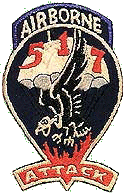INFANTRY REGIMENTAL COMBAT TEAM (SEPARATE)
IN THE VICINITY OF BERGSTEIN, GERMANY
4-8 FEBRUARY 1945. (RHINELAND CAMPAIGN)

By Capt. Roland L. Gohmert
THE PLAN OF ATTACK
At 0900 the morning of the 5th, the battalion staff and company commanders assembled at the CP to receive the attack order. The battalion commander stated that there was a force estimated to be one German parachute division facing the combined efforts of the 78th Division and the 517th Combat Team. These forces were believed to be in prepared positions on both sides of the Roer. The regimental plan was for the combat team to pass the line of departure about 100 yards east of Bergstein at 052400 with two battalions abreast, 2nd on the right, 3rd on the left. Each battalion was to move out in a column of companies guiding on the road leading south out of town, (Route A) cross the Kall River and seize objective one. The attack was to be initiated without an artillery preparation, in hopes that the main enemy defense could be penetrated by surprise and shock action. Objective one was to be secured by daylight, at which time the 3rd Battalion would swing north, clear the west bank of the Roer and seize objectives two and three. The 1st Battalion, which had been hardest hit in the preceding operations, was to occupy Hill 400 and then would revert to regimental reserve. As the Bergstein Ridge formed a deep salient into the enemy lines there would be no contact with friendly units on either flank until contact was made with the 310th Infantry, 78th Division, which was attacking from the south. The 460th Parachute FA Battalion was to be in general support of the combat team.
The battalion plan was for G Company, light machine gun platoon attached, to lead, followed by H Company, with I Company in reserve. The attached engineers from the 596th were to follow H Company, prepared to clear mines from the road, if any, and prepare a vehicle crossing of the Kall River. The 81mm mortar platoon was to be in general support from gun positions in Bergstein. Daylight reconnaissance was limited by 8th Division to two officers per rifle company, and necessary staff, with no reconnaissance beyond the 8th Division defenses. Resupply would be made to the objectives as required. White arm bands were to be worn at night for identification. The battalion aid station was to be in the vicinity of the CP in Bergstein. SOP radio nets were to be used until the objectives were taken, then normal wire was to be installed. (20)
While the attack order was being given a heavy enemy artillery concentration landed, and it was apparent that the enemy had detected some new American activity in the area. Following the order, reconnaissance parties were organized and the Headquarters Company personnel set about accomplishment of the supply and administrative matters necessary to initiate and support the attack. Due to the nature of the Brandenberg - Bergstein salient, movement along the Kleinhau - Bergstein Road was extremely difficult, Any vehicular movement east of Brandenberg brought down a hail of small arms and artillery fire. Consequently the reconnaissance parties moved from Brandenberg on foot and even then were forced to take cover at several points. Once in Bergstein it was possible to observe for great distances, but little could be seen to the immediate front due to the heavily wooded areas. Only the tree line of the Kall River, to the south could be observed, although Schmidt and surrounding towns were in plain view. The Schmidt - Brück - Hetzingen Road could be seen from Schmidt to a point 1,500 yards northeast of Harscheidt. To the east, after 200 - 300 yards of open ground, the woods obscured the terrain. Hill 400 dominated the wooded area. Due to the limited observation no enemy activity or fortifications were observed in the objective area. Almost all traces of snow were gone and the ground was extremely muddy and soft. The ground dropped off abruptly to the banks of the Roer and Kall Rivers on three sides of the point of the ridge, further obscuring observation. It was learned from officers of the 3rd Battalion, 113th Infantry, that for several weeks there had been little activity on the front except for exchanges of artillery and mortar fire. The only known enemy emplacement was a machine gun reported to be located approximately 300 yards down the road which was to be used in the attack. The troops in the 113th were dug deeply into the cellars of the demolished buildings and were protected by one towed anti-tank gun dug in on the right flank of the town. 517th reconnaissance parties noted that there was little space available for any installations. However there was one building on the northwestern outskirts of town with a portion of the lower floor still intact which was not occupied. This building was designated as both the battalion GP and aid station. Due to the inadequacy of the building it was decided that only the bare essential CP and medical personnel would come forward and the present CP would remain operational as battalion rear. Any movement in town during daylight, was strongly protested by members of the 113th, but it was finally agreed that the 81mm mortar platoon could move in and register before dark. All other personnel of the 517th were to move in after dark. (21)

